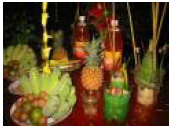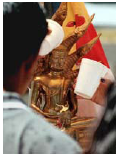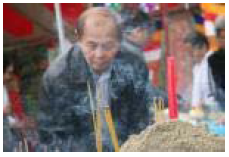
There are a number of different cultural activities which take place during the New Year. The activities encompass the religious believes and other cultural aspects.
Looking back, Khmer songs from the 60s and 70s provide insightful details to capture the New Year traditions. A song by legendary Khmer singer Sothear Serey Ros called "Chnam Tmey Mok Dol Hauy" or "The New Year Has Arrived" described how a group of girls got ready for the New Year by curling their hair, getting new dresses and doing make up. The daughters implore their parents not to stop them because the New Year only comes around once a year. Even if parents do give a big fuss, they cannot stop the girls. Sothear described a three-day festival of singing and dancing. They play the traditional games like Chhoung and Teang Prot (tug-of-war). While having fun, the girls should not forget to offer foods to the monks for blessings in the next life. The song was sung with the beat of Roam Kbach--a slow traditional dance beat.
The song "Phamuorng Tortea" (a type of silk dress for women) also sung by Sothear described how the guys and girls interact in the New Year. The song begins by describing a girl on her way to the temple wearing Phamuorng (silk dress) while others play a tug-of-war game. The young men secretly peeked and admired the young women around them. The women, at the same time, peeked at the handsome young men garbed in their finest for the occasion to impress the girls. One of the young men then began to flirt with the girls. The song went on to describe how her new dress made her look irresistible and the men drooled over her.
A song "Ongkunh Khei Bei" (Ongkunh with 3 heads) by Samouth Sin, Sothear Ros and Ron Pen mentioned the Ongkunh game which typically played during the New Year and how it led to love and marriage. The song started with Samouth throwing the Ongkunh and hitting the target pieces of the women's team. As he threw the Ongkunh he tried to memorize the face of the girl in the women's team he wanted to jours (to hit the losing team member by using Ongkunh to tap on the knee cap). Her Ongkunhs were arranged in a 3-head type and if he won he would get to tap her. She responded that if he hit the head Ongkunh first, he will loose. When she won, she will Jours him instead. Then he compared the tapping on the knee to telling their relatives about them. As she gets to jours him, it is like knowing his feelings and he will remember her for the rest of his life. She requested him not to jours her too hard and to leave some for tomorrow. She told him to tell his aunt and uncle to ask her for her hand in marriage in the New Year.
In the song "Bos Chhoung Chnam Tmey", Samouth and Sothear sang in a duet about the Chhoung game. This song is one of the actual beat and format used in playing the game as described in the later sections.
There are many various songs about dancing in the New Year such as "Roam Vong Chnam Tmey", "Saravan Chhnam Tmey", "Roam Leng Jole Chhnam", "Khae Chaet Chole Chhnam", and "Komsan Chhnam Tmey". These selected oldies described the culture for the New Year and passed on to the next generation the joy and the celebration of the New Year.
It is a common belief that life is full of mishap. People usually faced with the unfortunate events or sickness every day. To move away from those misfortunes, there is a need for a special ceremony with the chanting of monks and water sprinkling ceremony at the end of the year. So in the New Year, people change to new clothes and clean their home to feel that their bodies and souls are cleansed. They relax, have fun, and avoid thinking about the misfortunate events from the previous year. Thus, they begin a New Year with a new life full of prosperity.
Before the festival, people make several preparations to celebrate the New Year. They prepare food and items used in the ceremony. They prepare new clothes for themselves and others. They clean and decorate their home with colorful light bulbs or lamps with colorful decoration to welcome the New Year angel.
There is a belief that every New Year, one particular angel comes down to earth to represent the year. See more detail about New Year angle in the New Year folklore section. It is part of the tradition that people prepare items and food as offerings to the New Year angel. These items include:

During the preparation for the New Year or when the angel arrives, family members burn the incenses and candles; they spray the perfume to welcome the angel and wish for longevity, peace, and wealth.
During the New Year period, several religious ceremonies took place:
People bring food offering to the temple in the morning and then listen to monk chanting. In the afternoon, they take sand to build sand hill next to the temple or Bodhi tree. In the evening, people offer drinks to monks and invite monks to chant.
Son and daughters give clothes, money, and food to their parents or grandparents. They also give donation to the less fortunate people. In the afternoon, they participate in the building of sand hill ceremony by praying in front of the sand hill. Then follow by the monks’ praying for the families and friends who passed away offering them the path to sanctity known as Bangskole.
In the morning, they invite the monks to complete the building of sand hill ceremony. In the afternoon, they take part in the bathing ceremony by giving bath to parent by showering them with water and clean their feet. In addition, they participate in the bathing the Buddha statue ceremony by pouring water with perfume over the Buddha statue. Then they pray for prosperity.

The significant of giving bath in the New Year is to get good deeds. They believe that giving bath to parents and teachers or monks resulted in the greatest good deeds. In addition, the fruit of good deeds from bathing the Buddha statue ceremony will result in many blessings in the next life. These blessings include having great beauty, wisdom, bravery, health and wonderful children. [PHE01]
In the belief of good deeds, Cambodians free the birds, fishes, turtle, chicken and rabbit, and etc. These animals and birds will bring them longevity, happiness and good health.

The building of sand hill ceremony, known as Vealokchetei, symbolizes a stupa or cone shape structure used to store human remains. The sand hill structure represents a stupa called Cholamony Chaetdei where hair and diadem of Buddha were buried after his entry into Nirvana. This ceremony is believed to give the greatest fruit of good deeds for those who perform it. It can be seen in the folktales below.
According to [SIN03], the sand hill also symbolizes the relics of Buddha in India. The center of the big sand hill represents Mount Meru that stands for the center of the world. The other small hills represent the seven mountains that surrounded Mount Meru. Khmer people believe that each grain of the sand give the merit to those who perform this ceremony to be relieved of their misfortunes.
The process of building the sand hill is described in [PHE01]. It involved in bringing a big pile of sand to an area and shape into cones facing east. It is suggested to have one big hill in the center with 4 small hills located in the north, south, east, and west. Then create a Reajevat or fence decorated with coconut leaves creating entrances on 4 directions surrounded the hills. Around the fence, build 8 altars for the angels on all eight directions. On each altar, decorate with 2 Slathors, 2 one-level Bayseis, 5 candles, 5 incenses, 5 sets of betel leaves, areca nuts and cigarette, some grain, and flowers. Then burn the candles and pray to the angels.
In front of the sand hill outside the fence, construct 3 big altars to worship the Satan (king of the devils) in the center, Buddha to left, and Vishnou (principal Brahman deities) to the right. These three altars decorated similar to the angel's altars except using nine-level of Baysei instead of 2. They also have clothes and food as part of the offerings.
There are three folktales describes by Sinhour Torn [SIN03]. One of the folklores mentioned about a sailor who went on a sailing trip one day found a white sand hill on a beach. He stopped and gathered all of his business partners to build the sand hill as a stupa and started to pray. Then they offered a flower to the sand hill and walked around 3 times to show respect and honor before continuing their trip. As a result of this gesture, they all went to heaven for several lives - generations. When they were born as human and they became kings. At the end, the sailor enters into Nirvana. This is the result of building sand hill.
The other story mentioned about a boy Komjil Ksach (lazy sand boy) who like to build sand hill every day at the beach. When the supreme God sees this, he then awards the boy with a beautiful princess. He later became a king with the princess as his wife as a result of building sand hill.
The next story will be described in more details. Once upon a time there was an old fisherman who fishes for a living since he was a young boy. He killed and ate all kind of fishes for a living and had never performed any good deeds.
One day, a monk who knew about the situation felt sympathized for the fisherman and wanted to help him doing good deeds. So the monk waited in the path of the fisherman with alms bowl hoping that the fisherman would offer rice to the monk as a good deed. In the morning, the fisherman carried a harpoon and a wrapped of rice on his way to find fishes as usual. As he passed by monk on his way, he initially declined to offer his rice to the monk. When the monk kept on asking for some rice, the hunter then agreed to offer part of his rice to the monk.
Years later, when the fisherman passed away, the king of the devils took him to interrogate about his past life. The Satan asked the fisherman if he had done any good deeds when he was alive. The hunter said he had never done any good deed. Then the Satan threw him into the fire of hell. But instead burning in the fire, the fisherman was rejected by the fire. The Satan was shocked so he asked again if the fisherman has ever done any good deeds. As the hunter saw the orange flame, he was reminded of the orange rob of the monk and told the Satan that he once gave some rice to a monk. Then the devil said if so he can go to heaven for one week and on the 8th day the devil will get him back to hell to pay for his sin.
Then the hunter was born in the heaven as prince named Anaknang Lokaksen with great wealth and had a wife named Sovann Orei. As Anaknang enjoyed his life on the sixth day, he remembered the Satan's words about the eighth day and started to worry. His wife saw his sad face started to ask him. After hearing the story, she told him not to worry since Buddha said that those who have sin can build a sand hill. The result of good deeds for building sand hill shall relief that person from the sin. So Anaknang build the sand hill and complete the ceremony by the 7th day.
On the eighth day, the Satan came to call on him. His wife came out to answer the call. She told the Satan that her husband performed the building of sand hill ceremony and all of his sins should be relieved. If the Satan wants to take her husband to hell, the Satan must count all the grain of sand from a cup. If he finished the counting, he can take her husband. The Satan thought that it would easy to do and agreed to count the grain of sand.
From the morning until the evening, the Satan continues to count the sand from the cup. He noticed that the pile of sand that he already counted piled into a hill as tall as a palm tree but the sand in the cup stayed about the same. Satan realized that he would never finish the counting so he gave up and left without Anaknang.
Anaknang continues to live in the heaven for the rest of his life enjoying his wealth and he company of his wife. This is the fruit of good deeds from performing the sand hill ceremony.

| << New Year Songkran Picture | < Table of Content > | The Trot Dance >> |